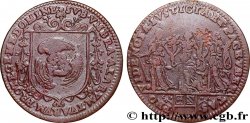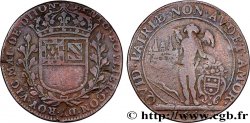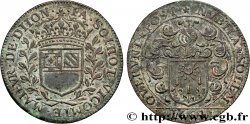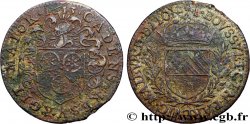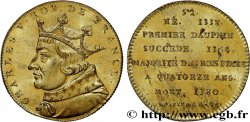fjt_771591 - DIJON (MAYORS OF ... and miscellaneous) Jean Joly 1689
10.00 €(Approx. 11.30$ | 8.60£)
Quantity
Add to your cart

Type : Jean Joly
Date: 1689
Metal : red copper
Diameter : 30 mm
Orientation dies : 6 h.
Weight : 8,21 g.
Edge : Lisse
Coments on the condition:
Patine hétérogène. Présence de faiblesses de frappe et de coups
Catalogue references :
Predigree :
Jeton provenant de la Collection MARINECHE
Obverse
Obverse legend : IEAN. IOLY. ESCUIER. CR. D. ROY. ME. DES. COMT. VIC. MAI. DE. DIION.
Obverse description : Armes de Jean Joly.
Reverse
Reverse legend : NON. NOVIT. SENECTVTEM. À L'EXERGUE : 1689.
Reverse description : Un aigle éployé de face, portant au coeur l'écu de Dijon.
Reverse translation : Il ne connaît pas la vieillesse.
Commentary
Sur la demande de Jean Joly, au mois de décembre 1668, furent publiées des lettres patentes enregistrées au parlement le 20 février 1669, sur un arrêt du Conseil d'Etat du 20 avril 1668 décidant : 1/la réduction de la magistrature de la ville de Dijon à des septemvirs, c'est à dire le maire, appelé vicomte-maieur, à six échevins, au procureur syndic, au secrétaire, au receveur, au contrôleur et à deux prud'hommes. 2/qu'on ne pourra être renommé à l'échevinage que quatre ans après en être sorti. 3/qu'il sera procédé à l'élection du maire de deux ans en deux ans, à commencer l'année 1670
Les maires de Dijon
Dès l’époque de la naissance de la féodalité, la ville de Dijon possédait un maire et en général vingt magistrats municipaux, ou échevins. Ces magistrats sont confirmés en 1187, lorsqu’une charte de commune est accordée par le duc Hugues III. En 1192, pour la première fois, le maire dijonnais est élu.
A la fin du XIIIe siècle, ce maire prend le titre de vicomte maïeur, confirmé en 1477-1479 par Louis XI, qu’il gardera jusqu’en 1789. Depuis la fin du XVe siècle (1491), la charge de vicomte maïeur est anoblissante ainsi que celle d’échevin à compter du XVIe siècle. Le vicomte maïeur avait le droit de haute, moyenne et basse justice, le droit de scel et de visite. Les clefs de la ville lui sont confiées et il dirige les archers ainsi que les compagnies des sept quartiers, cette fonction militaire étant importante jusqu’au XVIIe siècle.
Fonction élective, le vicomte maïeur est élu par les habitants, ni mendiants, ni étrangers, qui payent la taille, en général la veille de la Saint-Jean. Cette élection a lieu sur le parvis de l'église saint Philibert. A partir de 1669, il est permis au maire de porter "une robe longue de satin plein, de couleur violet, doublée de satin rouge cramoisi, comme le prévôt des marchands de Lyon, avec chaperon de même étoffe et couleur bordée d’hermine" afin de se distinguer des habitants.
En 1692, la fonction de vicomte maïeur est transformée en office héréditaire tandis que l’élection n’est plus alors qu’une confirmation du choix royal fait par le gouverneur au nom du roi.
Voir leur liste complète à http://fr.wikipedia.org/wiki/Liste_des_maires_de_Dijon.
Les maires de Dijon
Dès l’époque de la naissance de la féodalité, la ville de Dijon possédait un maire et en général vingt magistrats municipaux, ou échevins. Ces magistrats sont confirmés en 1187, lorsqu’une charte de commune est accordée par le duc Hugues III. En 1192, pour la première fois, le maire dijonnais est élu.
A la fin du XIIIe siècle, ce maire prend le titre de vicomte maïeur, confirmé en 1477-1479 par Louis XI, qu’il gardera jusqu’en 1789. Depuis la fin du XVe siècle (1491), la charge de vicomte maïeur est anoblissante ainsi que celle d’échevin à compter du XVIe siècle. Le vicomte maïeur avait le droit de haute, moyenne et basse justice, le droit de scel et de visite. Les clefs de la ville lui sont confiées et il dirige les archers ainsi que les compagnies des sept quartiers, cette fonction militaire étant importante jusqu’au XVIIe siècle.
Fonction élective, le vicomte maïeur est élu par les habitants, ni mendiants, ni étrangers, qui payent la taille, en général la veille de la Saint-Jean. Cette élection a lieu sur le parvis de l'église saint Philibert. A partir de 1669, il est permis au maire de porter "une robe longue de satin plein, de couleur violet, doublée de satin rouge cramoisi, comme le prévôt des marchands de Lyon, avec chaperon de même étoffe et couleur bordée d’hermine" afin de se distinguer des habitants.
En 1692, la fonction de vicomte maïeur est transformée en office héréditaire tandis que l’élection n’est plus alors qu’une confirmation du choix royal fait par le gouverneur au nom du roi.
Voir leur liste complète à http://fr.wikipedia.org/wiki/Liste_des_maires_de_Dijon.







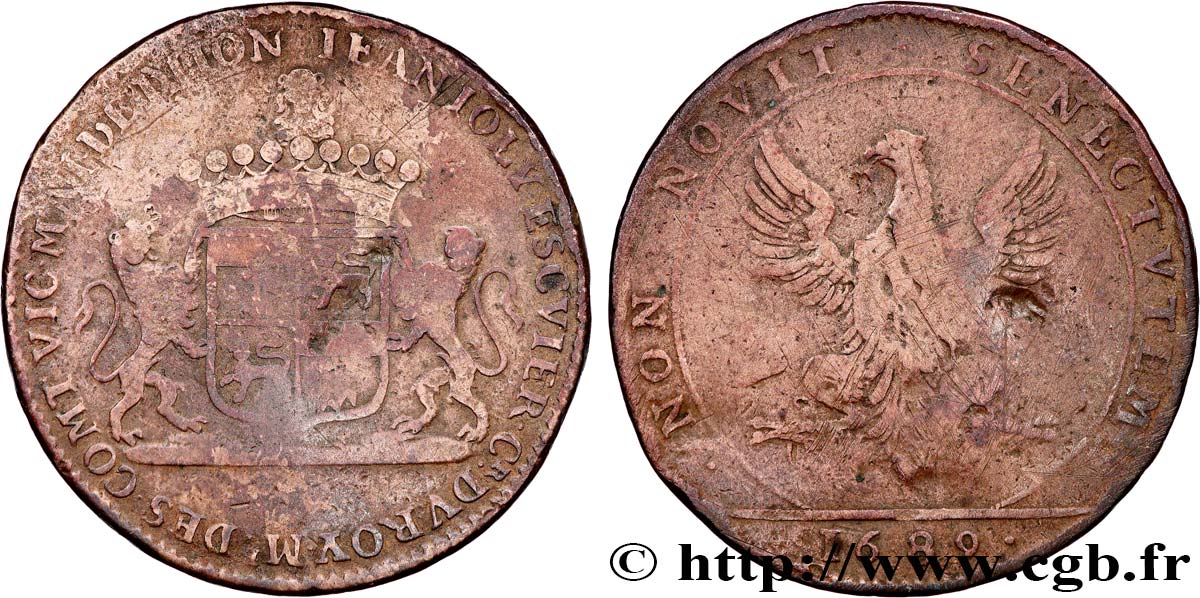
 Report a mistake
Report a mistake Print the page
Print the page Share my selection
Share my selection Ask a question
Ask a question Consign / sell
Consign / sell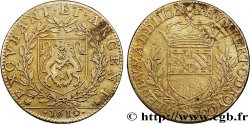
 Full data
Full data